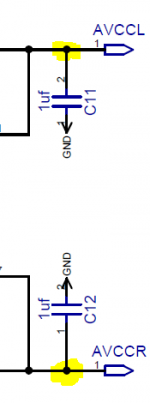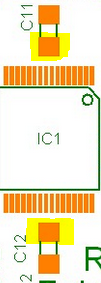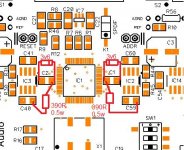One each from the +15V rail to "B" and "C".
And on the B24? To which caps?
edit, I think I get it, c11 and c12
Attachments
Last edited:
Thanks for sharing Russ🙂
Is this correct ? I drawn a pic if it helps
Yep you got it! 🙂
i tried using seperate sigma11 supply for avcc in my buffalo 1.2 and didnt notice any real significant change. a big improvement was seen when i remove the 3.3v ldo and feed directly with a sigma11. i must admit though that at 3.3V the sigma is probably not regulating very well, but still...
just wanted to share my experience so far
The reference for the analog supply is derived from the digital supply, so it makes sense that a better reference will improve the Vacc supply.
Zeners are noisy beasts - just look at the Salas Simplistic Shunt thread for the skinny on these - it takes something like 1000uF across them to bring that noise down to acceptable levels! So this won't be the quietest AVCC but probably better than stock. As Spartacus says deriving the analog supply from the digital supply does not lead to best reference V. Just my 2c.
The reference for the analog supply is derived from the digital supply, so it makes sense that a better reference will improve the Vacc supply.
Hi Spartacus,
This is debatable.
One of the things we looked at very very closely in the design transition from BUF24 to BUF32 was the AVCC VREF. We wanted to be sure it was not a weak link. What we learned really showed us something.
Measurements have proven that the current VREF with the filter is already excellent.
It would actually be pretty hard to get a "better" reference. As good, sure. But read on.
Remember that corner frequency of the VREF filter is EXTREMELY low. any noise would have to be sub 10hz, and I can tell you for certain there is no appreciable noise at all. 🙂
I explored this avenue very very thoroughly with other engineers.
Also keep in mind, that this is a differential DAC, with a fully differential output stage. Any disturbance on AVCC will be common mode to the outputs, and thus nullified very very nicely at the I/V stage. But that's is beside the point, because if you look at the VREF is stays nice and quiet, just as intended. 🙂 It is way cool that differential DACs work this way.
We actually purposefully injected broad band white noise (about 100mv amplitude) just before the VREF filter in one test, and it did not even register in DNR measurements. So it is a pretty robust filter. 🙂 I can assure it would never see anything remotely that challenging in normal use. 🙂
Cheers!
Russ
Last edited:
Zeners are noisy beasts - just look at the Salas Simplistic Shunt thread for the skinny on these - it takes something like 1000uF across them to bring that noise down to acceptable levels! So this won't be the quietest AVCC but probably better than stock. As Spartacus says deriving the analog supply from the digital supply does not lead to best reference V. Just my 2c.
The zener is there to protect, not to regulate. If the AVCC supply goes over the zener value excess current is safely shunted away. It normally does absolutely nothing.
Last edited:
The zener is there to protect, not to regulate. If the AVCC supply goes over the zener value excess current is safely shunted away. It normally does absolutely nothing.
Ah, yes I believe you're correct Russ in relation to the zener noise! Not so sure about the current vref though!
Ah, yes I believe you're correct Russ in relation to the zener noise! Not so sure about the current vref though!
Fortunately I have always been sure about both. 😉
I am not one to leave a theory untested.
Fortunately I have always been sure about both. 😉
Unfortunately, I think that might be the root of the problem 😀
What problem? Who has a problem? 😀
The excellent performance of the DAC is not happenstance. It is engineered.
And it is not the end of the story. Of course new achievements occur through research and development. Not blind faith and anecdotes. 🙂
And yes listening is my favorite type of research.
Keep in mind we experimented with a very clean CCS fed LED VREF with Buffalo24, and during the design phase of Buf32.
If it had been better it would have stayed. Simple as that. 🙂
Cheers!
Russ
The excellent performance of the DAC is not happenstance. It is engineered.
And it is not the end of the story. Of course new achievements occur through research and development. Not blind faith and anecdotes. 🙂
And yes listening is my favorite type of research.
Keep in mind we experimented with a very clean CCS fed LED VREF with Buffalo24, and during the design phase of Buf32.
If it had been better it would have stayed. Simple as that. 🙂
Cheers!
Russ
Will this mod be built into a future version of the 32S?
Enquiring minds want to know!
OK Guys here is fun little mod that works well.
Do this at your own risk. Mods are not supported period. 🙂 But they are fun. So if your hip, then go for it.
First to do it you need a fairly clean stiff regulator into VA+ and VA-. LCBPS is just fine. Placid even better.
Next you need to set those to 15V. (probably there already).
Now Grab a metal film 390R 1/2W resistor.
Connect one end to +15V and the other to AVCC(at the bypass cap).
You now have a good constant current source feeding the AVCC input just a tad more than it really needs, which the opamp will nicely dispose of the excess to keep at the reference voltage(3.3VDC). The opamp on AVCC now is a shunt element, or rather the combination is a whole local shunt regulator. The opamp is also now having to do a lot less work, making it work better.
Yes the resistor will get pretty warm. This is normal.
Now you have a shunt regulated AVCC supply. 🙂
Will you hear a difference??? I have no idea.
I found it pleasant.
As always have fun.
PS, yes you could use a CCD, JFET, or any other current source will work well (some better than others). You will want about 30-35ma per channel.
Cheers!
Russ
Enquiring minds want to know!
Anybody tried Rus's mod yet🙂
Hah, Well I have. 😉
And just for reference. the reason I was looking into it was really because I have been thinking for a long time how to keep those opamps running a bit cooler.
This seemed a good thing to try, and it worked very well.
If there is any change in the sound of the DAC it is very very subtle. 🙂
But those opamps seem a lot happier, and they should enjoy a longer life. And that was really part of the goal.
Cheers!
Russ
Totally agree there Russ , having those op-amps run cooler would be a very good idea, if the sound happens to be a little better that would be a small bonus😉
Soon as I get a couple of zeners I'll try it, I'd be tempted to try it without but if the small chance anything goes wrong and fries the dac I'd
Soon as I get a couple of zeners I'll try it, I'd be tempted to try it without but if the small chance anything goes wrong and fries the dac I'd

Russ,And just for reference. the reason I was looking into it was really because I have been thinking for a long time how to keep those opamps running a bit cooler.
I actually find those op ams to run much cooler than the ones on the analog rails which are burning to the touch. I am a little bit above 15V (15.3V). Any downside of lovering these rails to 12V?
Thanks,
Nic
Is the right pad of C59 directly connected to the VA+ rail?Thanks for sharing Russ🙂
Is this correct ? I drawn a pic if it helps
Sorry for the question but there is a lot of things to disconnect to find out what the via close to C54 connects to on the bottom side of the PCB🙂
Thanks,
Nic
Is the right pad of C59 directly connected to the VA+ rail?
Sorry for the question but there is a lot of things to disconnect to find out what the via close to C54 connects to on the bottom side of the PCB🙂
Thanks,
Nic
Yes, right pad of C59 goes straight to the op-amp +v pin7
- Status
- Not open for further replies.
- Home
- Source & Line
- Digital Line Level
- Buffalo Tweaking


